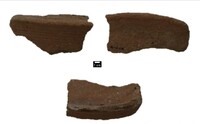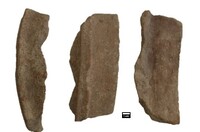-
 AF TTK 105 XRF processing and modelling
AF TTK 105 XRF processing and modelling XRF quantitative analysis processed by Olympus Vanta software. "Name" is referred to the shard code with a progressive number indicating different measurements spots. "Note" shows the location of measurement spots. The values of the elements are expressed as a percentage by weight. "LE" means light elements i.e. the amount of elements not detectable (Tatetsuki pottery Vanta chemistry XRF results.xlsx).
XRF quantitative analysis processed by Olympus Vanta software converted into oxides: SiO2, Al2O3, Fe2O3, CaO, MgO, K2O and TiO2. The conversion to oxides is obtained by multiplying the weight concentration of the element by a conversion factor derived from the ratio of molecular weight of the chosen oxide divided by the atomic weight of the elements. (Tatetsuki pottery Vanta chemistry XRF oxides results.xlsx).
-
 AF TTK 104 XRF processing and modelling
AF TTK 104 XRF processing and modelling XRF quantitative analysis processed by Olympus Vanta software. "Name" is referred to the shard code with a progressive number indicating different measurements spots. "Note" shows the location of measurement spots. The values of the elements are expressed as a percentage by weight. "LE" means light elements i.e. the amount of elements not detectable (Tatetsuki pottery Vanta chemistry XRF results.xlsx).
XRF quantitative analysis processed by Olympus Vanta software converted into oxides: SiO2, Al2O3, Fe2O3, CaO, MgO, K2O and TiO2. The conversion to oxides is obtained by multiplying the weight concentration of the element by a conversion factor derived from the ratio of molecular weight of the chosen oxide divided by the atomic weight of the elements. (Tatetsuki pottery Vanta chemistry XRF oxides results.xlsx).
-
 AF TTK 103 XRF processing and modelling
AF TTK 103 XRF processing and modelling XRF quantitative analysis processed by Olympus Vanta software. "Name" is referred to the shard code with a progressive number indicating different measurements spots. "Note" shows the location of measurement spots. The values of the elements are expressed as a percentage by weight. "LE" means light elements i.e. the amount of elements not detectable (Tatetsuki pottery Vanta chemistry XRF results.xlsx).
XRF quantitative analysis processed by Olympus Vanta software converted into oxides: SiO2, Al2O3, Fe2O3, CaO, MgO, K2O and TiO2. The conversion to oxides is obtained by multiplying the weight concentration of the element by a conversion factor derived from the ratio of molecular weight of the chosen oxide divided by the atomic weight of the elements. (Tatetsuki pottery Vanta chemistry XRF oxides results.xlsx).
-
 AF TTK 102 XRF processing and modelling
AF TTK 102 XRF processing and modelling XRF quantitative analysis processed by Olympus Vanta software. "Name" is referred to the shard code with a progressive number indicating different measurements spots. "Note" shows the location of measurement spots. The values of the elements are expressed as a percentage by weight. "LE" means light elements i.e. the amount of elements not detectable (Tatetsuki pottery Vanta chemistry XRF results.xlsx).
XRF quantitative analysis processed by Olympus Vanta software converted into oxides: SiO2, Al2O3, Fe2O3, CaO, MgO, K2O and TiO2. The conversion to oxides is obtained by multiplying the weight concentration of the element by a conversion factor derived from the ratio of molecular weight of the chosen oxide divided by the atomic weight of the elements. (Tatetsuki pottery Vanta chemistry XRF oxides results.xlsx).
-
 AF TTK 101 XRF processing and modelling
AF TTK 101 XRF processing and modelling XRF quantitative analysis processed by Olympus Vanta software. "Name" is referred to the shard code with a progressive number indicating different measurements spots. "Note" shows the location of measurement spots. The values of the elements are expressed as a percentage by weight. "LE" means light elements i.e. the amount of elements not detectable (Tatetsuki pottery Vanta chemistry XRF results.xlsx).
XRF quantitative analysis processed by Olympus Vanta software converted into oxides: SiO2, Al2O3, Fe2O3, CaO, MgO, K2O and TiO2. The conversion to oxides is obtained by multiplying the weight concentration of the element by a conversion factor derived from the ratio of molecular weight of the chosen oxide divided by the atomic weight of the elements. (Tatetsuki pottery Vanta chemistry XRF oxides results.xlsx).
-
AFC TBO STC 117* OM processing and modeling
Characterization of pottery shard based on stereomicroscopy. The observations takes in consideration the outer part (front), inner part (back) and the cross section of the shard, characterizing the clay matrix, inclusions and other peculiarities.
-
AF TBO STC 053 OM processing and modeling
Characterization of pottery shard based on stereomicroscopy. The observations takes in consideration the outer part (front), inner part (back) and the cross section of the shard, characterizing the clay matrix, inclusions and other peculiarities.
-
AF TBO STC 052 OM processing and modeling
Characterization of pottery shard based on stereomicroscopy. The observations takes in consideration the outer part (front), inner part (back) and the cross section of the shard, characterizing the clay matrix, inclusions and other peculiarities.
-
AF TBO STC 020* OM processing and modeling
Characterization of pottery shard based on stereomicroscopy. The observations takes in consideration the outer part (front), inner part (back) and the cross section of the shard, characterizing the clay matrix, inclusions and other peculiarities.
-
AF TBO 210 OM processing and modeling
Characterization of pottery shard based on stereomicroscopy. The observations takes in consideration the outer part (front), inner part (back) and the cross section of the shard, characterizing the clay matrix, inclusions and other peculiarities.
-
AF TBO STC 209 OM processing and modeling
Characterization of pottery shard based on stereomicroscopy. The observations takes in consideration the outer part (front), inner part (back) and the cross section of the shard, characterizing the clay matrix, inclusions and other peculiarities.
-
 AF TTK 133
AF TTK 133 Yayoi pottery - shard from a jar neck from Tatetski archaeological site.
-
 AF TTK 132
AF TTK 132 Yayoi pottery - shard from a jar rim from Tatetski archaeological site.
-
 AF TTK 131
AF TTK 131 Yayoi pottery - shard of foot from Tokusyu-Kidai (large ceremonial pot stands), from Tatetski archaeological site.
-
AF TBO STC 175A XRF Data interpretation
XRF data interpretation of metal shard based on elemental composition.
-
AF TBO STC 161A OM Data interpretation
Observation of corrosion products morphology.
-
AF TBO STC 183 CT Data interpretation
Details emerging from the resulting computed tomography and interpretation of 3D volume reconstruction of metal shard.
-
AF TBO STC 175A CT OM Data interpretation
Observation of corrosion products morphology by stereomicroscopy on finding exposed area in order to point details emerging from the resulting computed tomography and interpretation of 3D volume reconstruction of metal shard.
-
AF TBO STC 175A OM Data interpretation
Observation of corrosion products morphology. Finding exposed area in order to perform XRF analysis and computer tomography.
-
AF TBO 174 CT OM Data interpretation
Observation of corrosion products morphology by stereomicroscopy on finding exposed area in order to point details emerging from the resulting computed tomography and interpretation of 3D volume reconstruction of metal shard.
-
AF TBO 167 CT Data interpretation
Details emerging from the resulting computed tomography and interpretation of 3D volume reconstruction of metal shard.
-
AF TBO 166 CT Data interpretation
Details emerging from the resulting computed tomography and interpretation of 3D volume reconstruction of metal shard.
-
AF TBO STC 161A CT Data interpretation
Details emerging from the resulting computed tomography and interpretation of 3D volume reconstruction of metal shard.
-
AF TBO STC 160 CT Data interpretation
Details emerging from the resulting computed tomography and interpretation of 3D volume reconstruction of metal shard.
-
AF TBO STC 160 OM Data interpretation
Observation of corrosion products morphology.
 AF TTK 105 XRF processing and modelling XRF quantitative analysis processed by Olympus Vanta software. "Name" is referred to the shard code with a progressive number indicating different measurements spots. "Note" shows the location of measurement spots. The values of the elements are expressed as a percentage by weight. "LE" means light elements i.e. the amount of elements not detectable (Tatetsuki pottery Vanta chemistry XRF results.xlsx). XRF quantitative analysis processed by Olympus Vanta software converted into oxides: SiO2, Al2O3, Fe2O3, CaO, MgO, K2O and TiO2. The conversion to oxides is obtained by multiplying the weight concentration of the element by a conversion factor derived from the ratio of molecular weight of the chosen oxide divided by the atomic weight of the elements. (Tatetsuki pottery Vanta chemistry XRF oxides results.xlsx).
AF TTK 105 XRF processing and modelling XRF quantitative analysis processed by Olympus Vanta software. "Name" is referred to the shard code with a progressive number indicating different measurements spots. "Note" shows the location of measurement spots. The values of the elements are expressed as a percentage by weight. "LE" means light elements i.e. the amount of elements not detectable (Tatetsuki pottery Vanta chemistry XRF results.xlsx). XRF quantitative analysis processed by Olympus Vanta software converted into oxides: SiO2, Al2O3, Fe2O3, CaO, MgO, K2O and TiO2. The conversion to oxides is obtained by multiplying the weight concentration of the element by a conversion factor derived from the ratio of molecular weight of the chosen oxide divided by the atomic weight of the elements. (Tatetsuki pottery Vanta chemistry XRF oxides results.xlsx). AF TTK 104 XRF processing and modelling XRF quantitative analysis processed by Olympus Vanta software. "Name" is referred to the shard code with a progressive number indicating different measurements spots. "Note" shows the location of measurement spots. The values of the elements are expressed as a percentage by weight. "LE" means light elements i.e. the amount of elements not detectable (Tatetsuki pottery Vanta chemistry XRF results.xlsx). XRF quantitative analysis processed by Olympus Vanta software converted into oxides: SiO2, Al2O3, Fe2O3, CaO, MgO, K2O and TiO2. The conversion to oxides is obtained by multiplying the weight concentration of the element by a conversion factor derived from the ratio of molecular weight of the chosen oxide divided by the atomic weight of the elements. (Tatetsuki pottery Vanta chemistry XRF oxides results.xlsx).
AF TTK 104 XRF processing and modelling XRF quantitative analysis processed by Olympus Vanta software. "Name" is referred to the shard code with a progressive number indicating different measurements spots. "Note" shows the location of measurement spots. The values of the elements are expressed as a percentage by weight. "LE" means light elements i.e. the amount of elements not detectable (Tatetsuki pottery Vanta chemistry XRF results.xlsx). XRF quantitative analysis processed by Olympus Vanta software converted into oxides: SiO2, Al2O3, Fe2O3, CaO, MgO, K2O and TiO2. The conversion to oxides is obtained by multiplying the weight concentration of the element by a conversion factor derived from the ratio of molecular weight of the chosen oxide divided by the atomic weight of the elements. (Tatetsuki pottery Vanta chemistry XRF oxides results.xlsx). AF TTK 103 XRF processing and modelling XRF quantitative analysis processed by Olympus Vanta software. "Name" is referred to the shard code with a progressive number indicating different measurements spots. "Note" shows the location of measurement spots. The values of the elements are expressed as a percentage by weight. "LE" means light elements i.e. the amount of elements not detectable (Tatetsuki pottery Vanta chemistry XRF results.xlsx). XRF quantitative analysis processed by Olympus Vanta software converted into oxides: SiO2, Al2O3, Fe2O3, CaO, MgO, K2O and TiO2. The conversion to oxides is obtained by multiplying the weight concentration of the element by a conversion factor derived from the ratio of molecular weight of the chosen oxide divided by the atomic weight of the elements. (Tatetsuki pottery Vanta chemistry XRF oxides results.xlsx).
AF TTK 103 XRF processing and modelling XRF quantitative analysis processed by Olympus Vanta software. "Name" is referred to the shard code with a progressive number indicating different measurements spots. "Note" shows the location of measurement spots. The values of the elements are expressed as a percentage by weight. "LE" means light elements i.e. the amount of elements not detectable (Tatetsuki pottery Vanta chemistry XRF results.xlsx). XRF quantitative analysis processed by Olympus Vanta software converted into oxides: SiO2, Al2O3, Fe2O3, CaO, MgO, K2O and TiO2. The conversion to oxides is obtained by multiplying the weight concentration of the element by a conversion factor derived from the ratio of molecular weight of the chosen oxide divided by the atomic weight of the elements. (Tatetsuki pottery Vanta chemistry XRF oxides results.xlsx). AF TTK 102 XRF processing and modelling XRF quantitative analysis processed by Olympus Vanta software. "Name" is referred to the shard code with a progressive number indicating different measurements spots. "Note" shows the location of measurement spots. The values of the elements are expressed as a percentage by weight. "LE" means light elements i.e. the amount of elements not detectable (Tatetsuki pottery Vanta chemistry XRF results.xlsx). XRF quantitative analysis processed by Olympus Vanta software converted into oxides: SiO2, Al2O3, Fe2O3, CaO, MgO, K2O and TiO2. The conversion to oxides is obtained by multiplying the weight concentration of the element by a conversion factor derived from the ratio of molecular weight of the chosen oxide divided by the atomic weight of the elements. (Tatetsuki pottery Vanta chemistry XRF oxides results.xlsx).
AF TTK 102 XRF processing and modelling XRF quantitative analysis processed by Olympus Vanta software. "Name" is referred to the shard code with a progressive number indicating different measurements spots. "Note" shows the location of measurement spots. The values of the elements are expressed as a percentage by weight. "LE" means light elements i.e. the amount of elements not detectable (Tatetsuki pottery Vanta chemistry XRF results.xlsx). XRF quantitative analysis processed by Olympus Vanta software converted into oxides: SiO2, Al2O3, Fe2O3, CaO, MgO, K2O and TiO2. The conversion to oxides is obtained by multiplying the weight concentration of the element by a conversion factor derived from the ratio of molecular weight of the chosen oxide divided by the atomic weight of the elements. (Tatetsuki pottery Vanta chemistry XRF oxides results.xlsx). AF TTK 101 XRF processing and modelling XRF quantitative analysis processed by Olympus Vanta software. "Name" is referred to the shard code with a progressive number indicating different measurements spots. "Note" shows the location of measurement spots. The values of the elements are expressed as a percentage by weight. "LE" means light elements i.e. the amount of elements not detectable (Tatetsuki pottery Vanta chemistry XRF results.xlsx). XRF quantitative analysis processed by Olympus Vanta software converted into oxides: SiO2, Al2O3, Fe2O3, CaO, MgO, K2O and TiO2. The conversion to oxides is obtained by multiplying the weight concentration of the element by a conversion factor derived from the ratio of molecular weight of the chosen oxide divided by the atomic weight of the elements. (Tatetsuki pottery Vanta chemistry XRF oxides results.xlsx).
AF TTK 101 XRF processing and modelling XRF quantitative analysis processed by Olympus Vanta software. "Name" is referred to the shard code with a progressive number indicating different measurements spots. "Note" shows the location of measurement spots. The values of the elements are expressed as a percentage by weight. "LE" means light elements i.e. the amount of elements not detectable (Tatetsuki pottery Vanta chemistry XRF results.xlsx). XRF quantitative analysis processed by Olympus Vanta software converted into oxides: SiO2, Al2O3, Fe2O3, CaO, MgO, K2O and TiO2. The conversion to oxides is obtained by multiplying the weight concentration of the element by a conversion factor derived from the ratio of molecular weight of the chosen oxide divided by the atomic weight of the elements. (Tatetsuki pottery Vanta chemistry XRF oxides results.xlsx). AF TTK 133 Yayoi pottery - shard from a jar neck from Tatetski archaeological site.
AF TTK 133 Yayoi pottery - shard from a jar neck from Tatetski archaeological site. AF TTK 132 Yayoi pottery - shard from a jar rim from Tatetski archaeological site.
AF TTK 132 Yayoi pottery - shard from a jar rim from Tatetski archaeological site. AF TTK 131 Yayoi pottery - shard of foot from Tokusyu-Kidai (large ceremonial pot stands), from Tatetski archaeological site.
AF TTK 131 Yayoi pottery - shard of foot from Tokusyu-Kidai (large ceremonial pot stands), from Tatetski archaeological site.